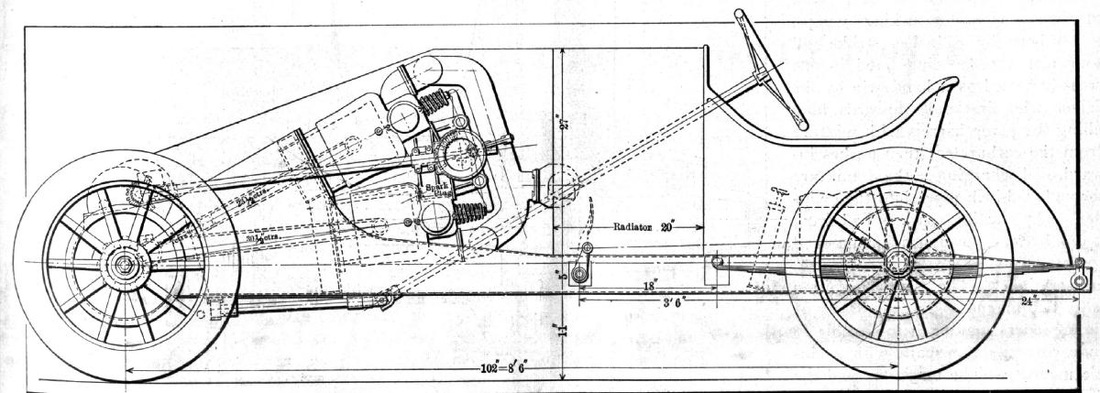Walter Christie built one last race car in 1909, and it was his best. The car was a masterpiece of clever packaging, with many examples of one part serving more than one function. For example, the engine block formed part of the chassis frame rails.
The engine was a V4 configuration, with his usual large displacement of 20.2 liters. In case you don't have your calculator handy, that would be 1237 cubic inches!
Christie had apparently learned that the GP car was carrying too much weight on the front wheels, so he shifted more to the rear with an extreme rearward inclination of the cylinders. This also gave the car a very low hood height, especially when compared to other inline 4 cylinder racers of the period. Christie finally gave up on atmospheric inlet valves, and used a SOHC with 2 large valves per cylinder. Ball bearings were used throughout the engine. Multiplate disc clutches replaced his old cone clutches.
Christie remained faithful to his patented system of direct front wheel drive with independent front suspension.
Walter Christie beat Barney Oldfield and others with his new car at Gross Pointe, Michigan in August of 1909. However, Walter gave up on his automobile business in early 1910. The car apparently sat idle until Barney Oldfield bought it in 1912. Barney would use the car for 4 years for some legitimate track record breaking exhibitions and match racing with Lincoln Beachey's airplane. The car was a real money maker for Barney. Amazingly, the old Christie survived World War I and was raced by Lou Disbrow until 1919. It was unfortunately scrapped in Chicago that year.
The engine was a V4 configuration, with his usual large displacement of 20.2 liters. In case you don't have your calculator handy, that would be 1237 cubic inches!
Christie had apparently learned that the GP car was carrying too much weight on the front wheels, so he shifted more to the rear with an extreme rearward inclination of the cylinders. This also gave the car a very low hood height, especially when compared to other inline 4 cylinder racers of the period. Christie finally gave up on atmospheric inlet valves, and used a SOHC with 2 large valves per cylinder. Ball bearings were used throughout the engine. Multiplate disc clutches replaced his old cone clutches.
Christie remained faithful to his patented system of direct front wheel drive with independent front suspension.
Walter Christie beat Barney Oldfield and others with his new car at Gross Pointe, Michigan in August of 1909. However, Walter gave up on his automobile business in early 1910. The car apparently sat idle until Barney Oldfield bought it in 1912. Barney would use the car for 4 years for some legitimate track record breaking exhibitions and match racing with Lincoln Beachey's airplane. The car was a real money maker for Barney. Amazingly, the old Christie survived World War I and was raced by Lou Disbrow until 1919. It was unfortunately scrapped in Chicago that year.






 RSS Feed
RSS Feed